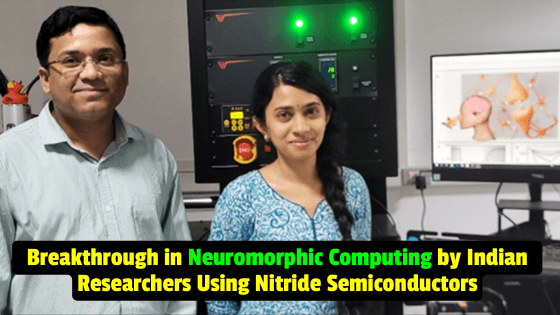Scientists at the Jawaharlal Nehru Centre for Advanced Scientific Research in Bengaluru, India, have developed an artificial synapse for brain-like computing with industry-compatible nitride semiconductors. The team used scandium nitride (ScN), a semiconducting material with supreme stability and Complementary Metal-Oxide-Semiconductor (CMOS) compatibility, to develop brain-like computing.
Bullet Point Summary:
- Scientists have developed an artificial synapse for brain-like computing with industry-compatible nitride semiconductors.
- ScN is a semiconducting material that is stable, CMOS-compatible and can be seamlessly integrated with existing Si technology.
- This invention has the potential to be translated into an industrial product.
Traditional computers have physically separated memory storage and processing units, which results in enormous energy and time to transfer data between these units during an operation. As a result, the human brain is a more efficient biological computer due to the presence of a synapse (the connection between two neurons) that plays the role of both processor and memory storage unit. In the current era of artificial intelligence, the brain-like computing approach can help meet the escalating computational demands.
The team used ScN to develop a device mimicking a synapse that controls the signal transmission and remembers the signal. This work by Dheemahi Rao and team demonstrates an artificial optoelectronic synapse with ScN thin films that can mimic synaptic functionalities like short-term memory, long-term memory, the transition from short-term to long-term memory, learning–forgetting, frequency selective optical filtering, frequency-dependent potentiation and depression, Hebbian learning, and logic-gate operations.
Additionally, with varying magnesium (Mg) dopant concentrations, both excitatory (increase in current/synaptic strength) and inhibitory (decrease in current/synaptic strength) operations can be achieved in the same material that is not readily possible with other materials. The increase in resistivity (negative photoconductivity) in ScN and decrease in resistivity (positive photoconductivity) in Mg-doped ScN on shining light was used as the excitatory and inhibitory nature of the synapse, respectively. The persistence in the photoconductivity after turning off the light acts as a memory that lasts for several minutes to several days, depending on the nature of the stimuli.
Compared to the existing materials used to demonstrate optoelectronic synapse, ScN is more stable, CMOS compatible, and can seamlessly integrate with existing Si technology. It can act as a platform for both excitatory and inhibitory functions. The industrial processing techniques of ScN are similar to the existing semiconductor fabrication infrastructure. Response to the optical stimuli also has the advantage of possible integration with photonic circuits known for higher speed and broader bandwidth than electronic circuits.
Outcomes:
- The study demonstrates the use of scandium nitride (ScN) as a semiconducting material for stable, CMOS-compatible optoelectronic synaptic functionalities at a relatively lower energy cost, making it a potential industrial product.
- The invention of an artificial synapses can help meet the escalating computational demands of the current era of artificial intelligence by mimicking a biological synapse that monitors and remembers the signal generated by the stimuli.
- This work is the first demonstration of an optoelectronic synapse with a CMOS chip-compatible group-III nitride semiconductor.
Q: What is the main goal of the study?
A: The study’s main goal is to develop an artificial synapse for brain-like computing with industry-compatible nitride semiconductors.
Q: What is the advantage of using scandium nitride (ScN) as a semiconducting material?
A: ScN has the advantage of being stable, CMOS-compatible and can be seamlessly integrated with existing Si technology. It can act as a platform for both excitatory and inhibitory functions and has the potential to be translated into an industrial product.
Q: How does the artificial synapse developed in the study compare to existing materials?
A: Compared to existing materials that demonstrate optoelectronic synapse, ScN is more stable, CMOS compatible, and can seamlessly integrate with existing Si technology. It can act as a platform for excitatory and inhibitory functions and has the advantage of possible integration with photonic circuits known for higher speed and broader bandwidth than electronic circuits.
Q: What are the potential benefits of developing brain-like computing?
A: The potential benefits of developing brain-like computing include meeting the escalating computational demands of the current era of artificial intelligence and mimicking a biological synapse that monitors and remembers the signal generated by the stimuli.
Q: What is the significance of this work?
A: This work is the first demonstration of an optoelectronic synapse with a CMOS chip-compatible group-III nitride semiconductor. It enables neuromorphic computing research with a stable, scalable, and CMOS-compatible III-nitride semiconductor that exhibits excitatory and inhibitory synaptic functionalities.
Scandium Nitride as a Gateway III-Nitride Semiconductor for both Excitatory and Inhibitory Optoelectronic Artificial Synaptic Devices
Rao; Indiradevi; Pillai; Garbrecht; Saha
Full text link: https://doi.org/10.1002/aelm.202200975
What this paper is about
- Due to the absence of resistance-capacitance delay, high bandwidth, and low power consumption, optoelectronic artificial synaptic devices are highly attractive.
- Here, epitaxial CMOS-compatible scandium nitride optoelectronic artificial synaptic devices that emulate both inhibitory and excitatory biological synaptic activities are presented.
- Mg doping is found to be effective in reducing the high electron concentration, and p-type ScN thin films have been demonstrated that also exhibit high thermoelectric power factor. This work utilizes persistent negative photoconductivity in intentionally undoped ScN, and persistent positive photoconductivity in Mg-doped ScN thin films to develop inhibitory and excitatory optoelectronic artificial synapses, respectively.
- These artificial synapses exhibit STM and LTM, transitions from STM-to-LTM, learning, frequency-controlled PPF and pairedpulse depression, dynamic filtering, symmetric STDP, and logic gate operations.
What you can learn
- Thus, NPC in degenerate ScN and PPC in Mg-doped ScN can be used as inhibitory and excitatory actions of a synapse, respectively, with the persistence in photoconductivity equated to the synaptic plasticity.
- With an increase in the stimuli strength in the form of more pulses, higher intensity, larger exposure time, and higher frequency, the persistence of photocurrent in both inhibitory and excitatory synapse increases that can be equated to their LTM.
- The change in conductivity due to the optical pulses is considered learning of the device, and restoration to the initial level is considered forgetting.
- Contrary to the previous demonstrations, both the inhibitory and excitatory synaptic functionalities are achieved in one host material.
- STM, LTM, and transition from the STM-to-LTM are demonstrated as a function of the strength of the input optical pulse tuned by its duration, number, power, and frequency.
- Scattering of photogenerated carriers with charged defect centers are found to result in the negative photoconductivity in undoped degenerate ScN.




